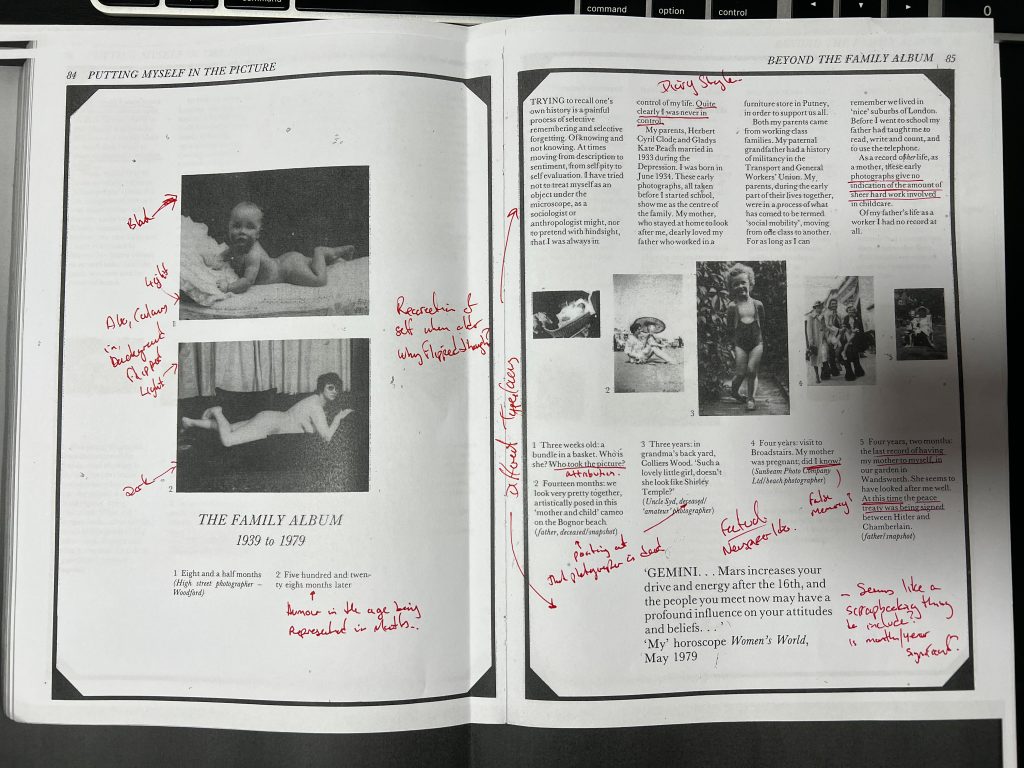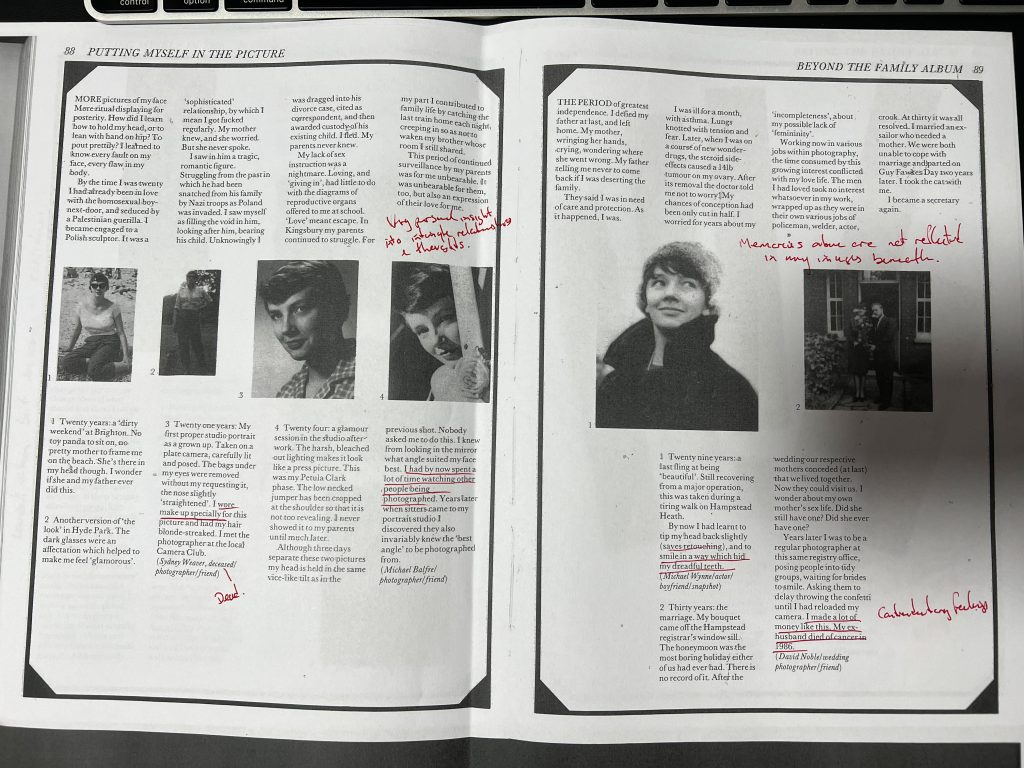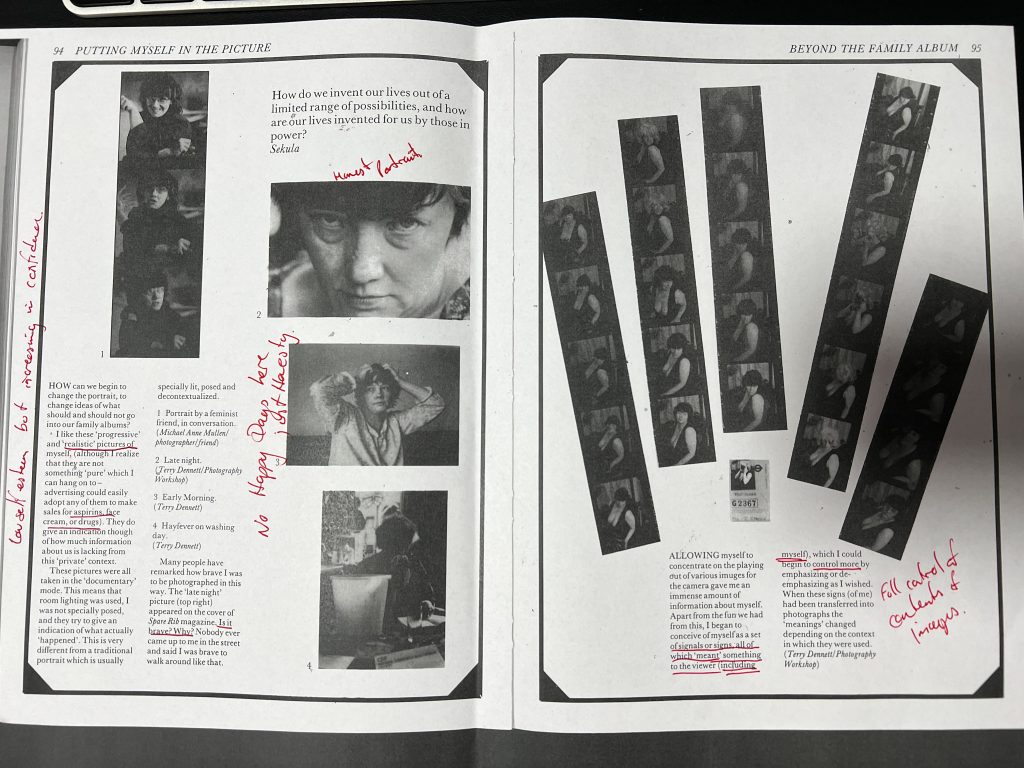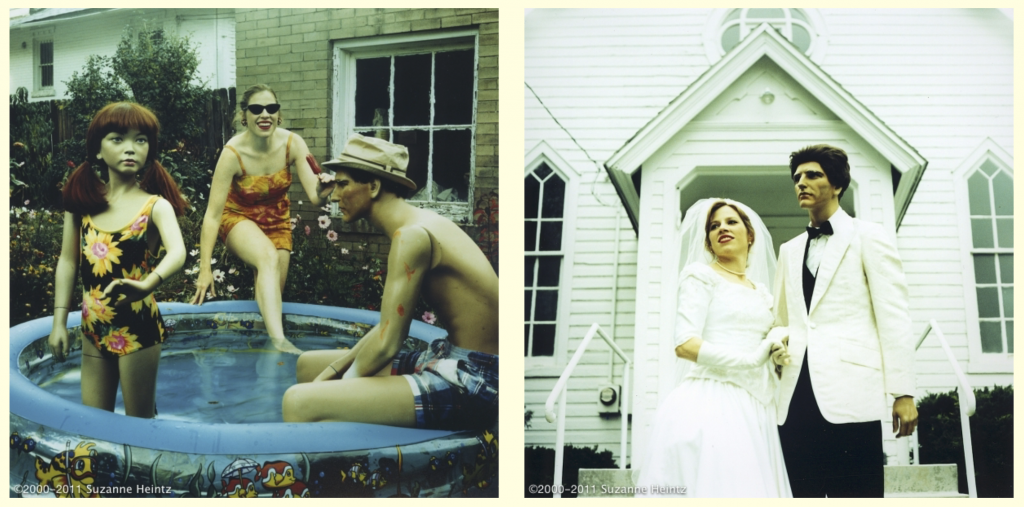Friday 3rd March 2023
We’re now half way through semester two.
Need to get a rough draft for the essay intro in for next Friday.
The Family Album
Alice shared some PowerPoint slides with us that talked about family albums like we all have tucked away in the house somewhere.
There were some interesting quotes she used from a book called Snapshots to Social Media – the Changing Picture of Domestic Photography, Springer London, Limited, 2011 by Risto Sarvas, David M. Frohlich
Reflection around Family Albums
We were asked to think about family albums for a while and then answer some questions
If you have family albums, what format do they take? What do they look like?
Our family albums are a mix of books with plastic sleeves in that hold photos, card pages with corner stickers that hold images in, packs of photos from the labs in a box, and also since 2000 most of the images nin our family album are stored on my hard drive.
What do they contain?
They contain mostly images of events that are important to the family, weddings, christenings, birthdays, parties, Christmas, holidays, pets, cars friends and family. My later albums contain lots of images that are used as a record of a process, either so I remember it or I used it to disassemble something so it was easier to reassemble.

How often do you look at them / through them?
The old physical photos are not looked at very often, some of mum’s are looked at monthly to keep her in touch with family and to test if she can remember details from her past. My digital photos are regularly displayed on my TV as a screensaver which is always entertaining when visitors are round ro a party is happening.
What value do they hold to you?
We discussed in the room how important they are and I’ve thought that in the event of a house fire it would be the first thing I’d grab to save, after my wife and children are safe of course.
Everything else in the house can be replaced, they’re physical items but the photos on the hard disk are precious, I’ve also digitised many of the physical photos so they’re all available in the same place so a fire wouldn’t take them all completely.
Who or what are family albums for?
Future generations can look back and see what their family looked like in the past, it’s worth noting it’s a curated version of the family.
I use my photos for memory aids also, so I know when something happened or where we went on holiday etc.
Has the act of creating a family album changed? How are photos of our lives recorded now?
Most of the photos captured around the world today are shared digitally, or kept on mobile devices. Many of them are stored in the cloud on the servers of an organisation like Microsoft, Google or Apple.
According to this 2019 article, approx. 1.8 billion photos are created every day this is an incredible number especially when many of them are never seen by another person.
TikTok, Snapchat, Twitter, Instagram, Facebook all host photos for their users so they can be stored and shared conveniently.

Not many photographs are ever printed out let alone added to an album. I think that there are some people who use instant photos and use these style images in scrapbook style affairs which could be thought of as albums but it’s difficult to say it’s a true family album.
How do you feel about the changes?
I’m actually anxious that photographs are stored digitally when we know that a Coronal Mass Ejection from the Sun can impact digital files stored on memory sticks, and hard drives whether they’re solid state or traditional disks. Storing them in the cloud, which is just someone else’s computer, is also troublesome to me as they can choose to halt access if they go bust or have a massive issue with a cyber attack. I personally keep all of my digital images on my computer’s hard disk, with a back up to an external hard disk and also to my NAS (Network Attached Storage) device.
Having all of my work in the control of someone else doesn’t sit well with me and I don’t tend to use a lot of cloud solutions for this reason.
Erik Kessels
We discussed a photographer called Erik Kessels who uses photos in exhibitions to highlight how family albums are used to represent the family. His exhibition “Album Beauty” was a discussion around this and he states that “We used to be the designers of our photo memories, not just someone who makes a slideshow on a computer. We don’t even have them in albums any more. The function of a photograph has shifted completely.”


Domestic Photography
We talked about “Domestic Photography” and what was meant by the term. It’s about how photography and equipment used to make family photos “lives” at home including cameras, computers, televisions, printers etc. It isn’t purely a subject that suits the nuclear man, wife and two kids family though. Domestic photography can be practiced by anyone, whether you’re alone or in a big family.
Snapshots
Snapshot photograph was discussed next and how that it was coined for hunting style shooting where a hunter takes the shot with his gun from the hip as there is no time to bring the gun up to aim. It was called a snap shot, and this term was used in photography too for photos made without a viewfinder, such as in early cameras where the lens was pointed in the general direction and you only find out what you’d captured when you had the photos back. It’s an amateur photography pursuit and all adds into the contents of the family album. More info in the book From snapshots to Social Media.
Alice also shared this quote by Annette Kuhn.
‘The photograph is a prop, a prompt, a pre-text: it sets the scene for recollection’ Anette Kuhn. Family Secrets: Acts of Memory and Imagination (London: Verso, 1995),13
Who is working with Family Albums?
We then discussed which artists make or have made work about the Family Album.
First up was Jo Spence who we discussed a couple of weeks ago and her body of work called Opening Up The Family Album, Alice gave us four A3 handouts which are copies of pages from the book and asked us to analyse the work to see what we could pick up from the work using the what, where ,who ,why, how methods we’ve used before.
Handout photos




The book shows the images with text above and below the images on the first few pages of this handout in a family album style. The pages are bordered and have the corners as you might see holding in a photo to an album. There is some deeply personal and intimate writing on the page in blocks and it’s joined by descriptions of the images that run through the page. There is a disconnect between the personal and factual sides, the photograph definitely doesn’t represent the story that appears in the confessional part of the writing.
As we move through the handouts we can see that she starts with zero control as a small child, pretty obvious when you think about it, to the very last page of the sheets in which she is controlling the images that are made. The picture called Late Night shows her in her natural state after a late bedtime. She jokes it could be used in advertising but she knows this is the real her. It doesn’t tell the whole story still, even if it is more realistic. The nuance and context we get int eh writing does not make itself evident in the images. She talks about the fact that she could not be a photographer who catches the real person in the picture, unless she could find the real her in the photographs of herself.
https://britishphotography.org/bodies-of-work/jo-spence-opening-up-the-family-album-1988-89/
Suzanne Heintz
Alice also shared with us the work of Suzanne Heintz, her Family project was made up of images of her in situations with other people being represented by mannequins.
We were asked to think about whath the work might have been about and why it had been made.

I looked a the first two images and made some notes.
To me it appeared to be a single woman recreating typical photos that might be seen in family albums, using mannequins to replace a husband or child. It spoke to me of a loneliness and a longing to be married with children.
The photos themselves are obviously staged yet Heintz has worked hard to make it appear that they’re candid action photos and as they’re all self portraits it makes me think of loneliness some more.
Are these dreams that she’s had and is trying to make them real as her life is not like this in any way. The wedding photo outside the chapel shows the bride and groom looking away from the camera as to make it look like a snapshot rather than a wedding photo taken by a wedding photographer.
http://www.suzanneheintz.com/photography/early-work/
It turns out that Heintz has been taking this family around making images in the usual places that people take these types of photos and it is an apparent comment on the fact that people are chasing perfection in images that are used on social media to make it look like they have a perfect life. This is not true, Instagram photos rarely portray the reality of family life, in the same way that family albums don’t usually contain photos of kids crying, injuries and bad things that happen to the family.
Alice also shared with us some other photographers who work with Family Albums.
Maria Tinaut
Created a risograph zine that saw reproductions of sections congaing women’s hands from her family photo albums. Her work Women’s Hans In My Family Album reflects the representation of women in her family. It allows the viewer of the work to focus on the touch aspect and divorce it from whomever owns the hand, this way there is no baggage attached to the hands. The riso method of printing brings to my mind that it’s like a photocopy of the original photo, and not a photo of the original that has been reproduced brilliantly.
http://www.issuu.com/genderfail/docs/womens_hands_documentation_1
Donovan Swann
Donovan Swann uses images from the family album and annotates them with text, usually handwritten to ask the questions that can never be answered by the contents of the photo itself, this way of writing onto images provides the context as to why this image is an image of import to the photographer or family album viewer.
Her work Studio Portrait uses distortion of the image, looks like it’s been sliced and then moved a little. Her work seems to chime with my year long project too. She talks of false representation of the family though and how it’s not what her family was really like.

Samira Alikhanzadeh
Next up was Samira Alikhanzadeh who uses found photos from the 40’s and 50’s in Tehran bazaars to create mixed media work using images much of the time too which helps the viewer to put themselves into the picture and see themselves reflected in the work. It’s an interesting take on the family album that helps contextualise the photo with localised materials etc.
She discusses that the subjects of the images are dead in much the same way as Barthes refers to loss in the Wintergarden Photograph, the subject of his book Camera Lucida. Even if the people are dead or not, the person at that particular time is long gone, and this is the same as any picture with a person in it. What was captured will never be again.
Further Reading:
We were given some further reading if we wanted to look into the family album more.
Marianne Hirsch and her book, Family Frames: photography narrative and post memory
Annette Kuhn: Family Secrets, Acts of memory and imagination.
Both of these authors and books sound like they’d tie in nicely to my essay topic on false memories coming from family album exposure. I’ll look into both of these, Hirsch’s book I’ve just picked up for £6.50 on the bay.
Other links:
http://www.eperjesi.hu/texts/agnes-berecz-time-past-picture-found?id=27Links to an external site.
http://samiraalikhanzadeh.com/base/en/home/#page1Links to an external site.
https://www.lacma.org/sites/default/files/press/2021-11/Family%20Album%20-%20Exhibition%20Advisory-9.8.21.pdfLinks to an external site.
https://www.frieze.com/article/joy-labinjos-family-albumLinks to an external site.
https://www.vice.com/en/article/xyjwa3/an-artist-puts-his-family-back-together-with-collaged-photosLinks to an external site.
https://www.creativereview.co.uk/vaughan-larsen-photography/Links to an external site.
https://irinawerning.com/back-to-the-future/Links to an external site.
Second Half: Essay Writing
The second half of the day’s lectures was surrounding the topic of Essay Writing.
Alice gave us access to the Writing Skills Handbook which will ultimately help us write the essay, and artists statement when we get to that in a few weeks time.
We had a discussion to ensure we understand what we need to do and I made a few limited notes where the info was something I hadn’t considered or documented. I think it will come in handy.
Essay Title needs to be informative.
Essay consists of Intro (10%), min body (80%) and conclusion (10%)
We should aim for one or two quotes/citations per paragraph and the structure of a paragraph should approximate:
- 1:Topic Sentence (consider it a mini title)
- 2: Argument
- 3: Evidence
- 4: Discussion
- 5: Concluding section or segue into next paragraph.
I’ve been researching many sources, from magazines, journals, books, videos and websites but we should make good use of journals as they’re peer reviewed and reliable material usually.
It should be written in the third person and not first person, so my current introduction needs a rewrite to remove the personal anecdote about the reason I’m writing that essay.
There are some requirements for the essay documented in canvas but the main ones I took note of were:
Point size needs to be 12, in a sensible typeface and using 1.5 spacing. This gives some room to write some notes in between the lines.
Refer to the Skills for Learning page for further useful tools on essay writing, academic writing and other resources.
It’s Binding Time
The last point was that we need to look at buying a bookbinding kit for the lesson on book binding coming up in a couple of weeks. We will be given some paper to bind if we haven’t created anything by then to use. I wonder if I have time, whether I might create some pages, up to 5 only, on Risograph and then bind these together in the workshop. It will be on 5 pieces of A4 which when folded into a book creates an a5 booklet. Something to think about. I’ve bought the kit off amazon for £8.50 with a bradawl and thread, as well as needles and “bone tools” made of plastic that help with creasing the paper correctly.
Conclusion Of The Day
Today was a useful session, especially the part about Family Albums. With my Essay currently being an investigation into the Family Album creating False Memories there was some good information in the lecture as well as some even better links to books and research that I cna further investigate.
I’m not so much fussed about the lies that photos tell or the fact that they don’t tell the whole story but rather how they’re viewed and used by today’s viewers. I don’t feel like I had a bad enough childhood to warrant tearing apart the album to find reasons for my idiosyncrasies today as I am happy with who I am, generally. I discussed in the last post about Richard Billingham’s work Ray’s A Laugh, how my dad was/is an alcoholic but it hasn’t deeply scarred me, I don’t think, enough to want to look into the family album that deeply. Saying that though, I wonder if like Tinaut’s Women’s hands work, if I went in and found the images of alcohol in all of the family photos whether it might add up to something. More food for thought!!!
Comments are closed.